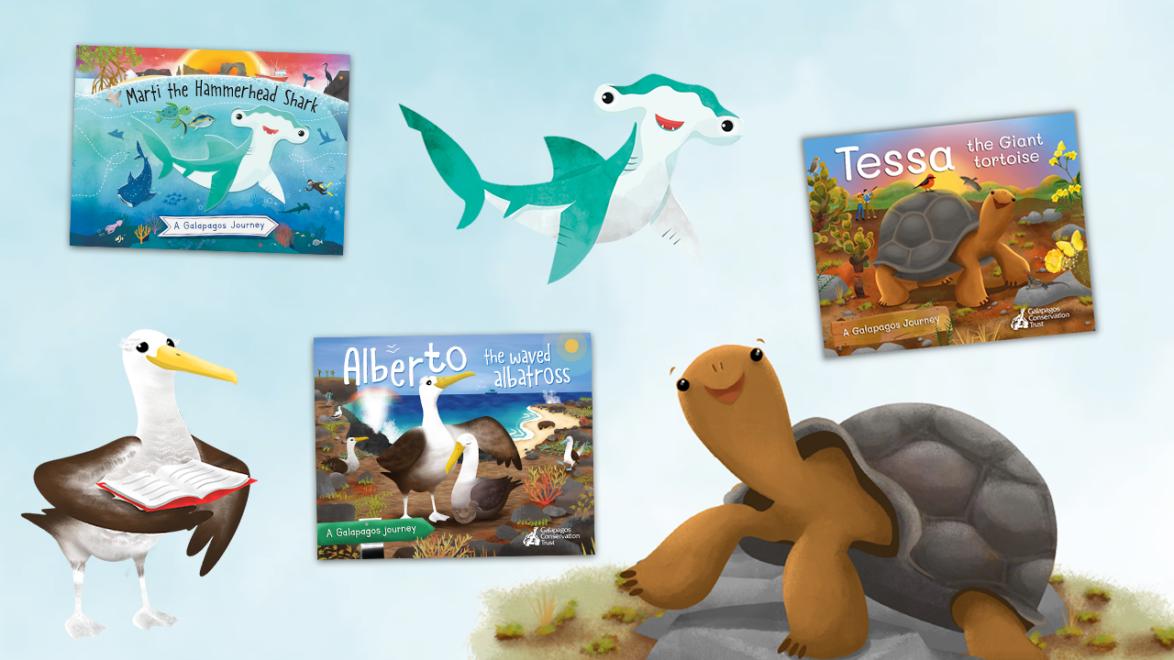

Meet the woman who brought Alberto the Waved Albatross to life
We asked Lisa Brown, illustrator of 'Alberto the Waved Albatross', about her experience bringing the storybook to life and the importance of using art to inspire environmental action.
We are thrilled to announce that our Alberto the Waved Albatross storybook is finally here! Join Alberto on his greatest adventure as he crosses the Ocean to reunite with his partner Isabela on Española island. Together, they must take on the challenge of raising a chick whilst overcoming many obstacles, including industrial fishing and plastic pollution.
Art has the power to impact us in a way that words alone often can’t, to mobilise our senses and emotions needed to inspire environmental action. We asked Lisa Brown, illustrator of Alberto the Waved Albatross and our two other storybooks, Marti the Hammerhead Shark and Tessa the Giant Tortoise, about her experience transforming words into illustrations and the benefits she believes art can have for people and wildlife.

Engaging children at a young age through art and storytelling is of paramount importance. Early exposure to these concepts fosters a life-long love for nature and a sense of responsibility for the environment.
How do you think art can be used to encourage people to connect with and protect wildlife?
Art is such a powerful medium to encourage people to connect with and protect wildlife. It appeals to our emotions and can convey the beauty, uniqueness and vulnerability of species in a way that facts and figures alone cannot. Art can be used to help bridge the gap between scientific knowledge and emotional connection, which can then inspire people to take action to protect species and their ecosystems, which is the ultimate goal!
The vivid and relatable characters in the Alberto the Waved Albatross storybook foster a sense of empathy, making children and adults feel a personal connection to the animals and their habitats. Conservation can be a complex subject, with many intricate parts and different factors involved, so visual communication is an effective way of condensing many ideas and communicating them simply.

What drew you to work with Galapagos Conservation Trust and illustrate the Alberto the Waved Albatross, Tessa the Giant Tortoise and Marti the Hammerhead Shark storybooks?
I was drawn to working with Galapagos Conservation Trust because of the organisation’s dedication to preserving the unique biodiversity of the Islands. I have a lifelong obsession with Galapagos and its wildlife, which began with my close bond with my Nan, with whom I regularly watched nature documentaries. She would be thrilled to see the work I have done with GCT, which makes me feel very emotionally invested in these projects.
The Islands are a remarkable place, with species found nowhere else on Earth, but they are vulnerable to the impacts of climate change, pollution, and invasive species. By illustrating storybooks like Marti the Hammerhead Shark, Tessa the Giant Tortoise and Alberto the Waved Albatross, I can raise awareness about these conservation challenges and the need to protect these fascinating creatures. It’s extremely rewarding, especially to see images of school children on the Islands enjoying the books and engaging with the messages – I feel so privileged to have been a part of this process.
Get your copy of Alberto the Waved Albatross
Visit our shop to order your copy of Alberto the Waved Albatross, the third in our series of educational storybooks!


What is your process for taking an idea and transforming it into a character?
Transforming a particular species into a character is probably a more methodical process than some would think. It involves research to understand the unique physical and behavioural characteristics of the species, so I start by collecting and studying lots of images of the animal and practice drawing them ‘true to life’.
I then try to simplify the animal into shapes (this helps with recreating them in different positions and poses) and then tweak those shapes to exaggerate the animal’s most defining features. For example, in Tessa the Giant Tortoise, I would focus on her enormous domed shell, cumbersome feet and long neck while capturing her gentle and slow-moving nature. In Marti the Hammerhead Shark, I would emphasise Marti’s sleek and distinctive body shape and give her a friendly and inquisitive expression to make her approachable to children.
Alberto’s defining feature is, of course, his massive wingspan, but also his large body when standing on land, so I tried to accentuate his big chest. I also took a particular liking to the waved albatross’ tufty ‘eyebrows’, which I thought added to their funny and endearing character!

How has creating the characters in the Alberto the Waved Albatross storybook compared to creating the characters in Tessa the Giant Tortoise and Marti the Hammerhead Shark?
I must admit I have found drawing Alberto a little harder than Tessa or Marti! I think it is partly because Albatrosses act and look very different on land versus in the sky – on land, they have quite an awkward top-heavy appearance, and in the sky, they look so graceful and majestic! However, this has allowed me to inject lots of character into the illustrations as they display a wide variety of behaviours and poses – from beak fencing and feather preening to soaring peacefully in the sunset and clumsily coming into land with a crash!
I have had lots of fun creating characters for the different storybooks and really enjoy the process of tailoring their visual and emotional appearance to the events in the stories. Alberto might have a more majestic and regal appearance to represent his life in the sky, while Marti the hammerhead shark would be designed to convey the grace and strength needed for miles of underwater navigation. Tessa the giant tortoise was depicted with a more ponderous and contemplative look, reflecting her slow, deliberate nature and arduous migration. Each character is unique, and I aim to capture the essence of the species in a way that resonates with the target audience.
Art is such a powerful medium to encourage people to connect with and protect wildlife. It appeals to our emotions and can convey the beauty, uniqueness and vulnerability of species in a way that facts and figures alone cannot.

How important is it to engage children at a young age in learning about the environment through educational initiatives such as art and storytelling?
Engaging children at a young age through art and storytelling is of paramount importance. Early exposure to these concepts fosters a life-long love for nature and a sense of responsibility for the environment. Just as we learn to talk through looking at pictures, we also learn what is important in the world through the subject matter of our early educational experiences.
Through captivating stories and appealing characters, we can inspire the next generation to become environmental stewards, advocating for conservation and making choices that protect the natural world. Art and storytelling offer a delightful and accessible way to educate children about the environment, nurturing their curiosity and empathy, which are crucial for a sustainable future.
Get ready for Christmas with GCT
Our beautiful new Christmas card, designed by Lisa Brown, features the colourful red-footed booby, one of the best known birds in Galapagos.

Connecting with Nature
Our Connecting with Nature programme allows young people in Galapagos to experience the incredible flora and fauna around them, fostering a love for nature and strong sustainable values.
Related articles


Gills Club: Empowering young women in Galapagos

An interview with marine biologist Dr Joanna Alfaro


